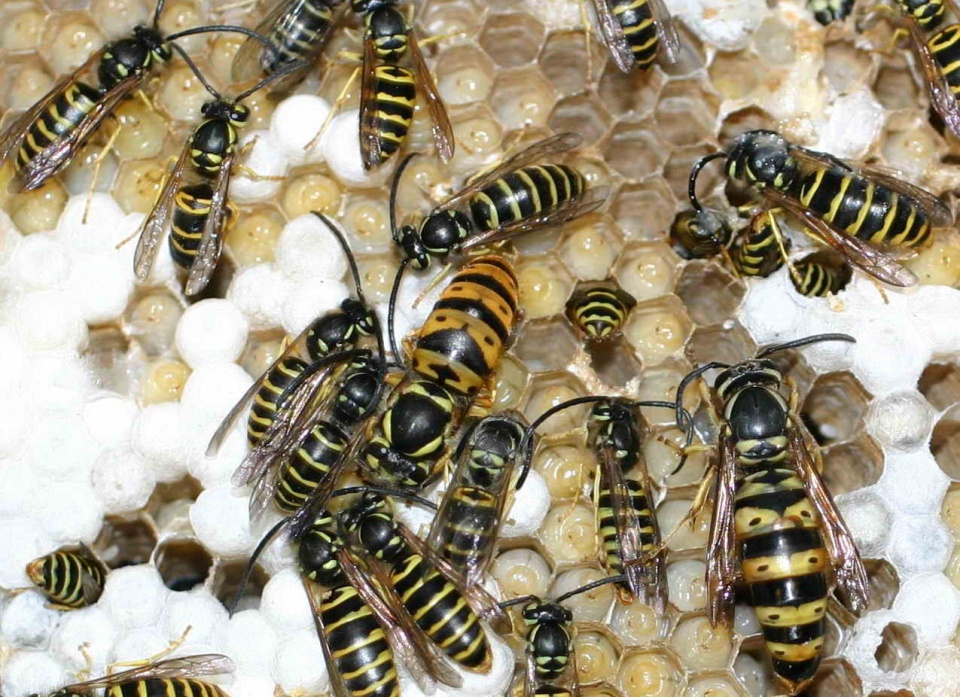Genome Sequencing Could Unlock Answers to Yellow Jacket Behavior

Photo courtesy of Goodisman Research Group.
The most recognizable yellow jacket at Georgia Tech is made of fabric and foam, but Professor Mike Goodisman and a team of researchers revealed a far more complex cellular structure by successfully sequencing the genome of two local species of yellow jacket wasps — Vespula squamosa (the southern yellow jacket) and Vespula maculifrons (the eastern yellow jacket).
Having the genome sequences of yellow jacket wasps expands biologists' understanding of the behaviors and evolution of social insects, including the intricacies of the caste system made up of queens, males, and workers.
"The genome is fundamental for a lot of questions that we ask," Goodisman said.
The research, published in Annals of the Entomological Society of America, identifies rates of gene evolution among the different species, which Goodisman says could offer explanations for the various roles each wasp plays in their colonies as well as their ability to adapt and thrive in different environments. Variations in the genomes will also help scientists dissect the interactions between the two local species.
Southern and eastern yellow jacket queens produce all caste members in the colony, and while mated queens from both species hibernate in the winter following the decline of their colonies, V. squamosa will stay in hibernation slightly longer. Southern queens then actively seek out established eastern yellow jacket nests, kill the resident queen, and take over her colony. Goodisman and his research team hope the genome provides insight into the southern queens’ parasitic behavior.
The typical colony will survive six to eight months, but in certain climates, colonies can outlast the winter months to become "supercolonies." These larger colonies take on multiple queens as they grow to the size of a couch or a car. Goodisman's team will use the genome to look for clues as to how these supercolonies thrive for multiple years and how natural selection operates in the two species.
Throughout the study, Goodisman relied on the Georgia Tech community's shared interest in the social insect to gather the necessary samples. Through ads in The Whistle and other campus publications, he collected yellow jacket wasps’ nests from faculty, staff, and alumni, in addition to samples from around the region. DNA was extracted from individual wasp samples and then sent to the University of Georgia for DNA sequencing. The resulting genomes, which are about 200 million base pairs in length, were then jointly analyzed by scientists at Georgia Tech and the University of Georgia.
“When you get the data back, you get these long sequences of the building blocks of DNA. Part of the game is putting that together like a puzzle, and then we analyze the sequence to figure out what it means,” he said.
With the genome sequenced, the team can then compare the local species to each other and all species of yellow jacket wasps worldwide. Unlike honeybees, yellow jacket wasps are not considered significant pollinators, but because their diet consists of insects and carrion, Goodisman explains that understanding their place in the ecosystems they inhabit is equally important.
He is enthused to be on a campus that shares his interest in the group of social insects known as Hymenoptera. That interest led him to study insects like fruit flies at Cornell University and fire ants at the University of Georgia before beginning his postdoctoral research on other members of the Hymenoptera order.
Now, when discussing his research with members of the Georgia Tech community, he finds himself answering one question more than any other. His response is always the same. "Because of the stinger, Buzz is anatomically female."
And while he can't definitively say which species of yellow jacket the mascot would be, Goodisman said Buzz's feisty nature would lean toward the more aggressive and charismatic southern yellow jacket, V. squamosa.